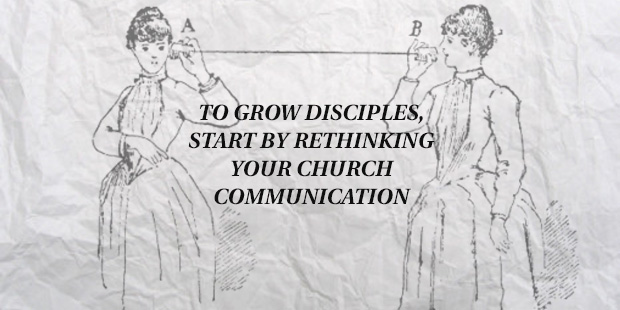
To Grow Disciples, Start by Rethinking Your Church Communication
Are you familiar with the well-known website, church marketing sucks? Or, if you’re put off, perhaps church marketing stinks? I’ve always loved the blunt challenge the domain presents against the dominant framework most local congregations bring to the idea of church communication. Like the site’s owners, I am against misunderstanding church communication as a mere tool to share information. I am very much for using church communication to strategically shape a church’s story and create a covenantal community.
Unfortunately, most churches define the role of communication as the tactical execution of messages designed by other church leaders. It is a support position, like clip art on a desktop publishing PC. A popular post defines it well, here.
There’s a reason for this poor understanding of church communication, and it is killing efforts to grow churches and make disciples of Jesus Christ.
20th century advertising was defined by “features and benefits,” or information about the attributes of a product. Features provided the point of view of the producer – what the product offers. Benefits provide the point of view of the customer – how the product helps their life. Both angles assume the person on the other end of the transaction is a consumer. This is precisely the problem with most communication in churches – it adopts a strategic assumption that is consumer-driven and transactional. It treats the “seeker”, or the person coming to church, as a consumer, to receive spiritual goods and services, and it makes the relationship transactional in nature, when biblically speaking it should be covenantal.
Now, I don’t think this is all the church’s fault. It is the default mode of our society, and the person coming to church will, without thinking, approach their spiritual life in the same way they approach everything else. We have to teach people what it means to be covenantal rather than transactional.
The newer advertising philosophy, which I have advocated in my ministry, is experiential. Rather than thinking about a product’s features and benefits, it attempts to create an environment for finding meaning. Most major campaigns now do this. Advertisers are exploring how to create what is essentially a more covenantal approach to their craft – they desire to create brand promises with their customers and forge long-term relationships. Of course their goal is still to sell products, but we can learn from this. Many church leaders still operate, I think by default, in a features and benefits mentality.
This gets at the heart of the dichotomy between “attractional” and “missional,” as I discussed earlier. The debate on whether a church should be “missional” or “attractional” is a false dichotomy. It is both/and, not either/or. As friend Mike Slaughter says, “The gospel is offensive. We’re just making sure you know you’ve been offended.”
Obviously, clear communication is vitally important. How a church presents its identity both in its core story and in its ongoing daily messages determines what audience it engages. A church that finds its core story in relating to people “burnt by church” is going to present itself, or tell its story, differently than a church of people who have found great personal benefit in the combination of church and society (like many of the churches in Dallas I used to work with). This also means you must know your audience, which is a future topic for this blog.
In the meantime, if you want to grow disciples in your church, re-thinking church communication is a great place to start.
Read more from Len here.

Tags: Attention, Awareness, Brand, Church Communication, Len Wilson












